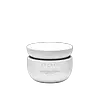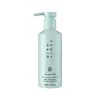What's inside
What's inside
 Key Ingredients
Key Ingredients

 Benefits
Benefits

 Concerns
Concerns

 Ingredients Side-by-side
Ingredients Side-by-side

Water
Skin ConditioningCetearyl Alcohol
EmollientPropanediol
SolventHydrogenated Ethylhexyl Olivate
EmollientButyrospermum Parkii Butter
Skin ConditioningBehentrimonium Chloride
PreservativeLactobacillus
Skin ConditioningAstrocaryum Murumuru Seed Butter
EmollientOlea Europaea Fruit Oil
MaskingSodium Hyaluronate
HumectantSqualane
EmollientAdansonia Digitata Seed Oil
EmollientArgania Spinosa Kernel Oil
EmollientBoswellia Carterii Resin Extract
MaskingHyssopus Officinalis Leaf Oil
Skin ConditioningMoringa Oleifera Seed Oil
EmollientNigella Sativa Seed Oil
EmollientOrbignya Speciosa Kernel Oil
EmollientCitrullus Lanatus Seed Oil
EmollientHydrogenated Olive Oil Unsaponifiables
EmollientHelianthus Annuus Seed Extract
Skin ConditioningC9-12 Alkane
SolventCetrimonium Chloride
AntimicrobialPolyquaternium-10
Stearalkonium Chloride
PreservativeCetyl Hydroxyethylcellulose
Emulsion StabilisingPhytic Acid
Caramel
Cosmetic ColorantCoco-Caprylate/Caprate
EmollientCitric Acid
BufferingParfum
MaskingPotassium Sorbate
PreservativePhenoxyethanol
PreservativeDipropylene Glycol
HumectantStearyl Alcohol
EmollientSilica Dimethyl Silylate
EmollientHydrated Silica
AbrasiveSodium Phosphate
BufferingDisodium Phosphate
BufferingTocopherol
AntioxidantLinalool
PerfumingWater, Cetearyl Alcohol, Propanediol, Hydrogenated Ethylhexyl Olivate, Butyrospermum Parkii Butter, Behentrimonium Chloride, Lactobacillus, Astrocaryum Murumuru Seed Butter, Olea Europaea Fruit Oil, Sodium Hyaluronate, Squalane, Adansonia Digitata Seed Oil, Argania Spinosa Kernel Oil, Boswellia Carterii Resin Extract, Hyssopus Officinalis Leaf Oil, Moringa Oleifera Seed Oil, Nigella Sativa Seed Oil, Orbignya Speciosa Kernel Oil, Citrullus Lanatus Seed Oil, Hydrogenated Olive Oil Unsaponifiables, Helianthus Annuus Seed Extract, C9-12 Alkane, Cetrimonium Chloride, Polyquaternium-10, Stearalkonium Chloride, Cetyl Hydroxyethylcellulose, Phytic Acid, Caramel, Coco-Caprylate/Caprate, Citric Acid, Parfum, Potassium Sorbate, Phenoxyethanol, Dipropylene Glycol, Stearyl Alcohol, Silica Dimethyl Silylate, Hydrated Silica, Sodium Phosphate, Disodium Phosphate, Tocopherol, Linalool
Water
Skin ConditioningCetearyl Alcohol
EmollientGlycerin
HumectantBehentrimonium Chloride
PreservativeBrassicamidopropyl Dimethylamine
Skin ConditioningPropanediol
SolventGlyceryl Ricinoleate
EmollientHydrolyzed Vegetable Protein
Skin ConditioningPereskia Aculeata Callus Extract
Panthenol
Skin ConditioningCamellia Sinensis Leaf Extract
AntimicrobialAlanine
MaskingArginine
MaskingAspartic Acid
MaskingGlycine
BufferingHistidine
HumectantIsoleucine
Skin ConditioningPhenylalanine
MaskingProline
Skin ConditioningSerine
MaskingTartaric Acid
BufferingThreonine
Valine
MaskingCocos Nucifera Water
MaskingButyrospermum Parkii Butter Unsaponifiables
Skin ConditioningCocos Nucifera Fruit Juice
EmollientGelidiella Acerosa Extract
Skin ProtectingHelianthus Annuus Extract
EmollientHypnea Musciformis Extract
Skin ProtectingMomordica Cochinchinensis Seed Extract
Skin ConditioningOryza Sativa Bran Extract
Skin ConditioningPCA
HumectantRicinus Communis Seed Oil
MaskingRosmarinus Officinalis Leaf Extract
AntimicrobialSodium PCA
HumectantVaccinium Myrtillus Seed Oil
Skin ConditioningHydroxypropylgluconamide
HumectantEthyl Oleate
EmollientPolyquaternium-73
Hydroxypropylammonium Gluconate
HumectantEthyl Stearate
EmollientGuar Hydroxypropyltrimonium Chloride
Skin ConditioningEthyl Linoleate
EmollientEthyl Palmitate
EmollientLactobacillus Ferment
Skin ConditioningSteapyrium Chloride
AntimicrobialPolyquaternium-113
Citric Acid
BufferingSorbic Acid
PreservativeSodium Lactate
BufferingTocopherol
AntioxidantSodium Hydroxide
BufferingTetrasodium Glutamate Diacetate
Sodium Metabisulfite
AntioxidantLeuconostoc/Radish Root Ferment Filtrate
AntimicrobialCaprylyl Glycol
EmollientPotassium Sorbate
PreservativeSodium Benzoate
MaskingEthylhexylglycerin
Skin ConditioningPhenoxyethanol
PreservativeBenzyl Alcohol
PerfumingParfum
MaskingBenzyl Salicylate
PerfumingHexyl Cinnamal
PerfumingLimonene
PerfumingLinalool
PerfumingWater, Cetearyl Alcohol, Glycerin, Behentrimonium Chloride, Brassicamidopropyl Dimethylamine, Propanediol, Glyceryl Ricinoleate, Hydrolyzed Vegetable Protein, Pereskia Aculeata Callus Extract, Panthenol, Camellia Sinensis Leaf Extract, Alanine, Arginine, Aspartic Acid, Glycine, Histidine, Isoleucine, Phenylalanine, Proline, Serine, Tartaric Acid, Threonine, Valine, Cocos Nucifera Water, Butyrospermum Parkii Butter Unsaponifiables, Cocos Nucifera Fruit Juice, Gelidiella Acerosa Extract, Helianthus Annuus Extract, Hypnea Musciformis Extract, Momordica Cochinchinensis Seed Extract, Oryza Sativa Bran Extract, PCA, Ricinus Communis Seed Oil, Rosmarinus Officinalis Leaf Extract, Sodium PCA, Vaccinium Myrtillus Seed Oil, Hydroxypropylgluconamide, Ethyl Oleate, Polyquaternium-73, Hydroxypropylammonium Gluconate, Ethyl Stearate, Guar Hydroxypropyltrimonium Chloride, Ethyl Linoleate, Ethyl Palmitate, Lactobacillus Ferment, Steapyrium Chloride, Polyquaternium-113, Citric Acid, Sorbic Acid, Sodium Lactate, Tocopherol, Sodium Hydroxide, Tetrasodium Glutamate Diacetate, Sodium Metabisulfite, Leuconostoc/Radish Root Ferment Filtrate, Caprylyl Glycol, Potassium Sorbate, Sodium Benzoate, Ethylhexylglycerin, Phenoxyethanol, Benzyl Alcohol, Parfum, Benzyl Salicylate, Hexyl Cinnamal, Limonene, Linalool
Ingredients Explained
These ingredients are found in both products.
Ingredients higher up in an ingredient list are typically present in a larger amount.
This ingredient is a preservative and often used for it's anti-static properties. You'll most likely see this ingredient in hair conditioners.
It does not cause irritation or sensitization in leave-on products at 1-5%.
Cetearyl alcohol is a mixture of two fatty alcohols: cetyl alcohol and stearyl alcohol. It is mainly used as an emulsifier. Emulsifiers help prevent the separation of oils and products. Due to its composition, it can also be used to thicken a product or help create foam.
Cetearyl alcohol is an emollient. Emollients help soothe and hydrate the skin by trapping moisture.
Studies show Cetearyl alcohol is non-toxic and non-irritating. The FDA allows products labeled "alcohol-free" to have fatty alcohols.
This ingredient is usually derived from plant oils such as palm, vegetable, or coconut oils. There is debate on whether this ingredient will cause acne.
Due to the fatty acid base, this ingredient may not be Malassezia folliculitis safe.
Learn more about Cetearyl AlcoholCitric Acid is an alpha hydroxy acid (AHA) naturally found in citrus fruits like oranges, lemons, and limes.
Like other AHAs, citric acid can exfoliate skin by breaking down the bonds that hold dead skin cells together. This helps reveal smoother and brighter skin underneath.
However, this exfoliating effect only happens at high concentrations (20%) which can be hard to find in cosmetic products.
Due to this, citric acid is usually included in small amounts as a pH adjuster. This helps keep products slightly more acidic and compatible with skin's natural pH.
In skincare formulas, citric acid can:
While it can provide some skin benefits, research shows lactic acid and glycolic acid are generally more effective and less irritating exfoliants.
Most citric acid used in skincare today is made by fermenting sugars (usually from molasses). This synthetic version is identical to the natural citrus form but easier to stabilize and use in formulations.
Read more about some other popular AHA's here:
Learn more about Citric AcidLinalool is a fragrance and helps add scent to products. It's derived from common plants such as cinnamon, mint, citrus, and lavender.
Like Limonene, this ingredient oxidizes when exposed to air. Oxidized linalool can cause allergies and skin sensitivity.
This ingredient has a scent that is floral, spicy tropical, and citrus-like.
Learn more about LinaloolParfum is a catch-all term for an ingredient or more that is used to give a scent to products.
Also called "fragrance", this ingredient can be a blend of hundreds of chemicals or plant oils. This means every product with "fragrance" or "parfum" in the ingredients list is a different mixture.
For instance, Habanolide is a proprietary trade name for a specific aroma chemical. When used as a fragrance ingredient in cosmetics, most aroma chemicals fall under the broad labeling category of “FRAGRANCE” or “PARFUM” according to EU and US regulations.
The term 'parfum' or 'fragrance' is not regulated in many countries. In many cases, it is up to the brand to define this term.
For instance, many brands choose to label themselves as "fragrance-free" because they are not using synthetic fragrances. However, their products may still contain ingredients such as essential oils that are considered a fragrance by INCI standards.
One example is Calendula flower extract. Calendula is an essential oil that still imparts a scent or 'fragrance'.
Depending on the blend, the ingredients in the mixture can cause allergies and sensitivities on the skin. Some ingredients that are known EU allergens include linalool and citronellol.
Parfum can also be used to mask or cover an unpleasant scent.
The bottom line is: not all fragrances/parfum/ingredients are created equally. If you are worried about fragrances, we recommend taking a closer look at an ingredient. And of course, we always recommend speaking with a professional.
Learn more about ParfumPhenoxyethanol is a preservative that has germicide, antimicrobial, and aromatic properties. Studies show that phenoxyethanol can prevent microbial growth. By itself, it has a scent that is similar to that of a rose.
It's often used in formulations along with Caprylyl Glycol to preserve the shelf life of products.
Potassium Sorbate is a preservative used to prevent yeast and mold in products. It is commonly found in both cosmetic and food products.
This ingredient comes from potassium salt derived from sorbic acid. Sorbic acid is a natural antibiotic and effective against fungus.
Both potassium sorbate and sorbic acid can be found in baked goods, cheeses, dried meats, dried fruit, ice cream, pickles, wine, yogurt, and more.
You'll often find this ingredient used with other preservatives.
Learn more about Potassium SorbatePropanediol is an all-star ingredient. It softens, hydrates, and smooths the skin.
It’s often used to:
Propanediol is not likely to cause sensitivity and considered safe to use. It is derived from corn or petroleum with a clear color and no scent.
Learn more about PropanediolTocopherol (also known as Vitamin E) is a common antioxidant used to help protect the skin from free-radicals and strengthen the skin barrier. It's also fat soluble - this means our skin is great at absorbing it.
Vitamin E also helps keep your natural skin lipids healthy. Your lipid skin barrier naturally consists of lipids, ceramides, and fatty acids. Vitamin E offers extra protection for your skin’s lipid barrier, keeping your skin healthy and nourished.
Another benefit is a bit of UV protection. Vitamin E helps reduce the damage caused by UVB rays. (It should not replace your sunscreen). Combining it with Vitamin C can decrease sunburned cells and hyperpigmentation after UV exposure.
You might have noticed Vitamin E + C often paired together. This is because it is great at stabilizing Vitamin C. Using the two together helps increase the effectiveness of both ingredients.
There are often claims that Vitamin E can reduce/prevent scarring, but these claims haven't been confirmed by scientific research.
Learn more about TocopherolWater. It's the most common cosmetic ingredient of all. You'll usually see it at the top of ingredient lists, meaning that it makes up the largest part of the product.
So why is it so popular? Water most often acts as a solvent - this means that it helps dissolve other ingredients into the formulation.
You'll also recognize water as that liquid we all need to stay alive. If you see this, drink a glass of water. Stay hydrated!
Learn more about Water